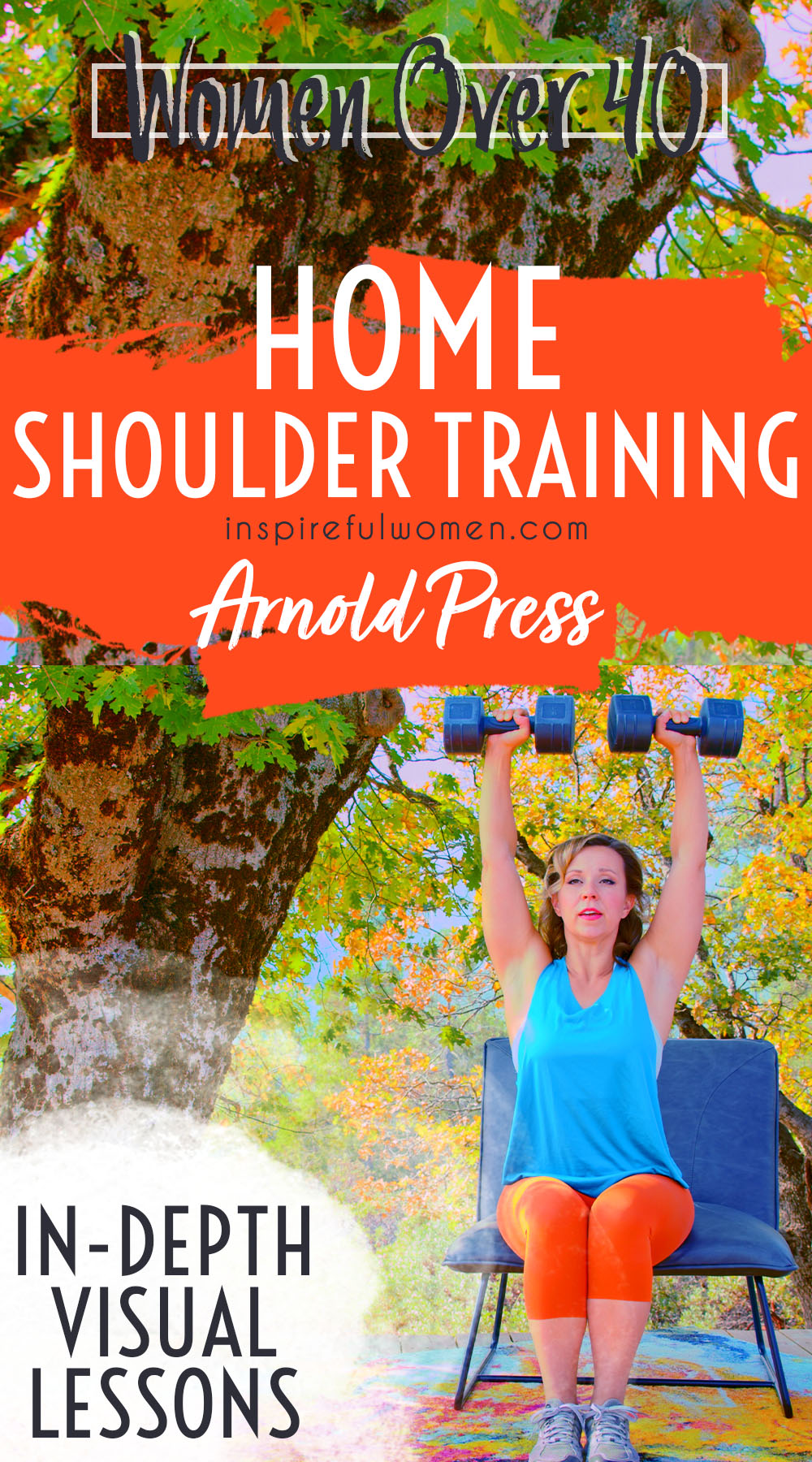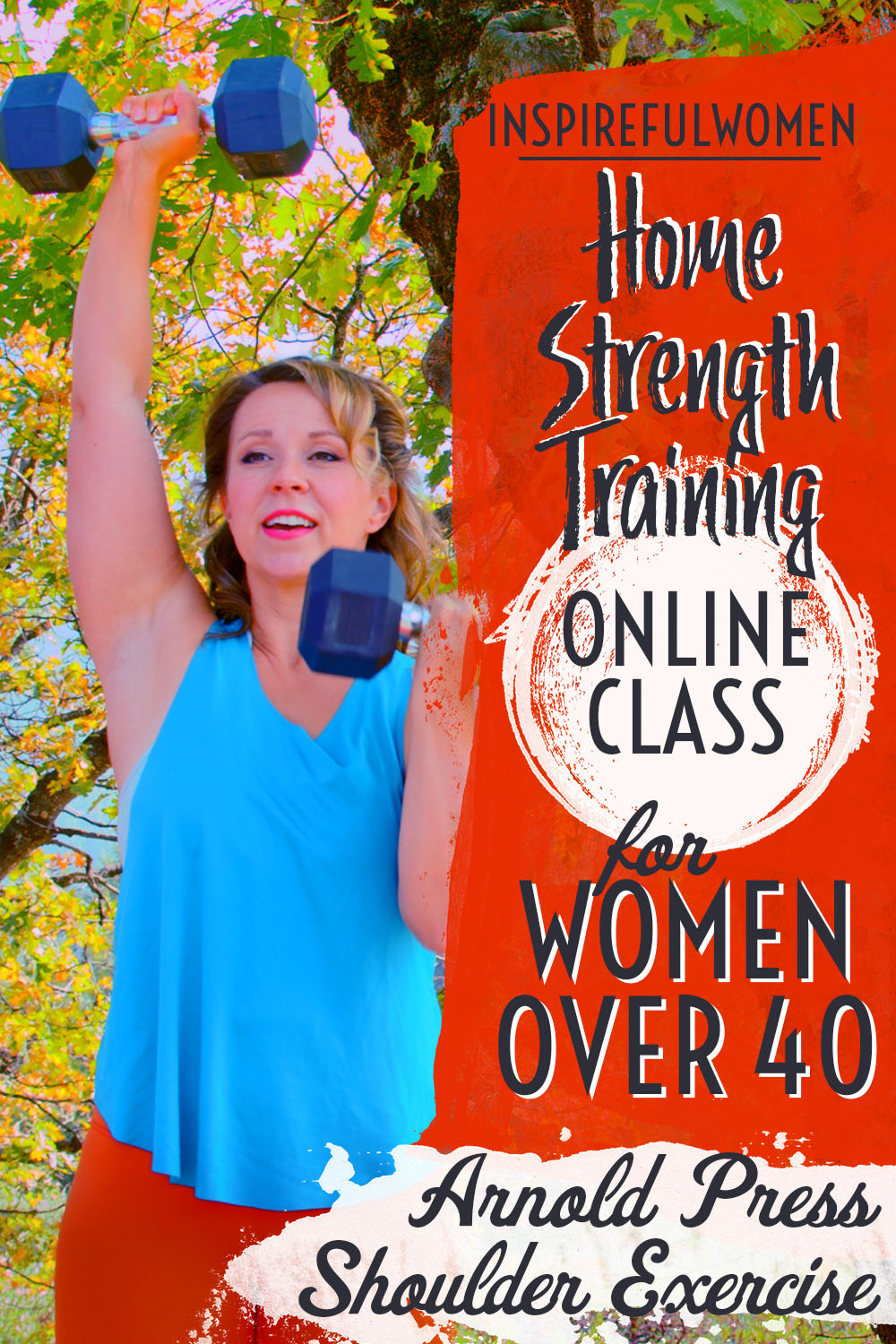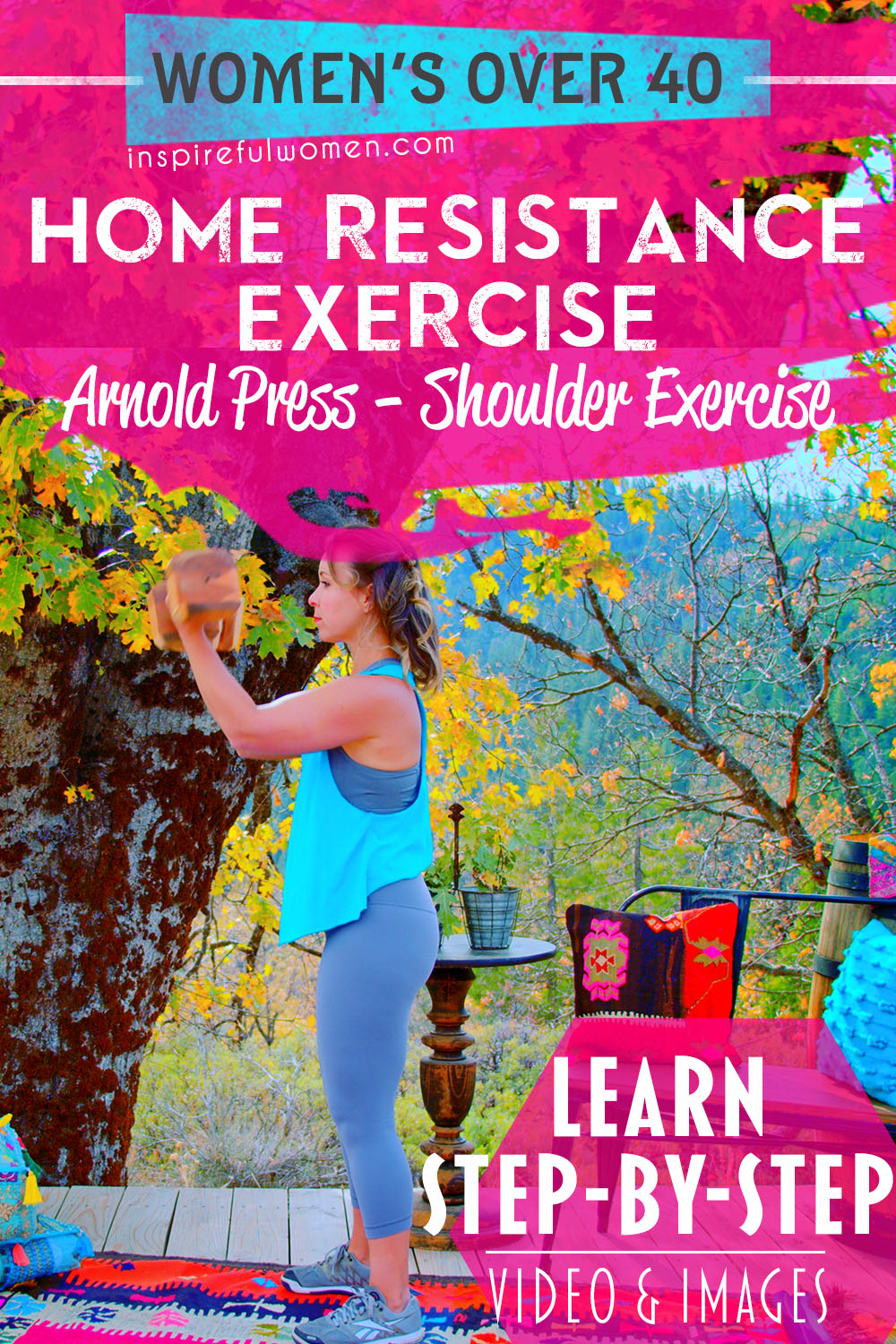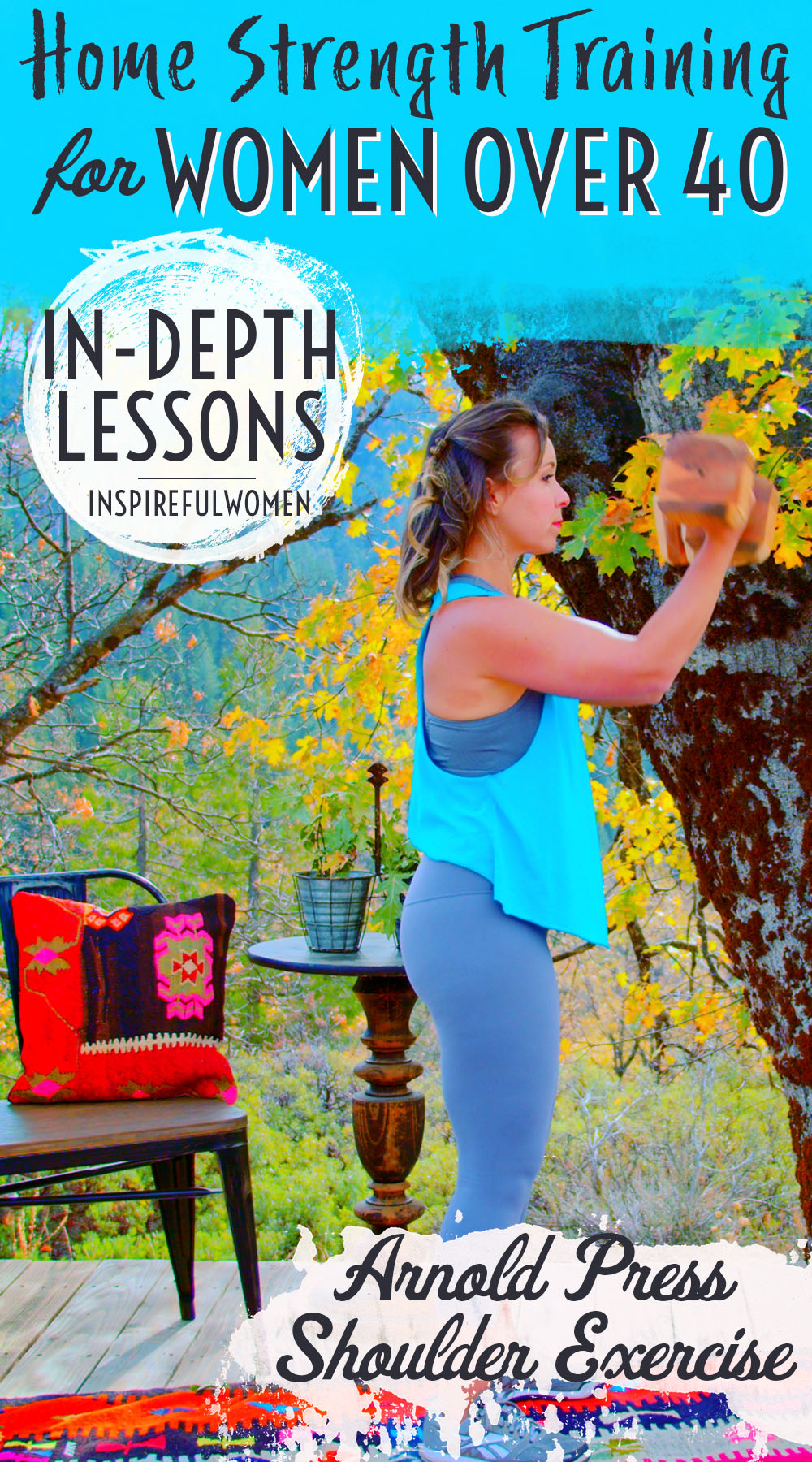Dumbbell Arnold Press
How to Do the Dumbbell Arnold Press | In-Depth Guide [VISUAL LEARNERS]
Proper Form, Common Mistakes, Variations + Easier & Harder | Home Resistance Training
WHAT DO YOU WANT TO SEE?
QUICK DEMO
QUICK DEMO
MUSCLES THIS WORKS
MUSCLES
MAIN MUSCLES WORKED IN the Dumbbell Arnold Press
Deltoids
AKA YOUR MAIN SHOULDER MUSCLE.
OTHER MUSCLES WORKED:
- Rotator cuff
- Scapular muscles
WHAT WE'RE DOING TODAY
WHAT & WHY
BENEFITS OF TRAINING THE SHOULDERS
WHAT
WHAT WE'RE DOING TODAY
ALL WE'RE DOING:
This one is a must-watch-video exercise.
CHANGING UP THE REGULAR OL' SHOULDER PRESS
The Arnold Press is an overhead pressing movement that works many of the muscles of the upper body in coordination. This is a more advanced shoulder press variation, so it is very helpful if you can comfortably do a standard overhead shoulder press before progressing to the Arnold Press.
This movement involves lifting the arms up and out to the side as they are lifted overhead. This movement sounds pretty straightforward, but there is a lot going on here. The arm is moving in five different directions! Forward, to the side, to the back, and rotating in and out. The muscles that move and stabilize the shoulder blade, along with the rotator cuff muscles will be working throughout the entire movement to make sure that the arm is correctly positioned in the shoulder joint.
The Arnold Press is designed to work all three parts of the deltoid muscle, the front, side, and back fibers. It can help to think of the movement as three separate movements that target each part.
Think of the arm lifting up, moving out towards the side and slightly back as the arms are pressed overhead. In addition to this, there is a rotation that happens in the shoulder joint. It is helpful to think of the upper arm bone rotating in the shoulder socket as opposed to thinking about the forearm position.
Make sure you have warmed up your upper body before doing this movement. It is also important to pay close attention to proper form during this particular movement to keep your shoulders and back safe. Avoid the urge to do too many reps or use too much weight in the beginning, and always monitor your response during and after - even a day or two.
WHY BOTHER DOING IT?
WHY
WHY DO WE EVEN CARE?
TRAIN IN ALL 3 PLANES OF MOTION WITH ONE EXERCISE
The Arnold press is an advanced movement that works many upper body muscles with one exercise. There are three parts of the deltoid muscle, the front fibers (anterior deltoid), the middle fibers (lateral deltoid), and the rear fibers (posterior deltoid). Each part of the deltoid has a different function the front fibers can lift the arm to the front and also rotate it in, the middle fibers lift the arm out to the side, the posterior fibers move the arm back and rotate it out. All three parts of the deltoid along with the rotator cuff and the muscles that move the shoulder blade need to work in coordination for controlled and healthy movements of the arm.
This exercise trains the muscles to work together as the arm moves through three different planes of motion. The muscles all work together in coordination as the arm moves through all three planes of motion as it is lifted out to the front, out towards the side, and upwards and back. The arm also moves through rotation.
PREVENT INJURING ONE OF THE MOST COMMONLY INJURED JOINTS
Damage to the shoulder joint is pretty common. Almost everyone either has had shoulder pain or an injury or knows someone who has. It is also one area that can be most debilitating. Shoulder pain can limit your ability to do essential daily activities like dressing, toileting, grooming, and eating. It is also extremely difficult to sleep when you have a shoulder injury. Training the muscles of the upper back and shoulder can help to improve the stability and mobility of the shoulder joint to prevent damage to the joint.
The main cause of damage to the shoulder joint is poor movement (poor joint mechanics). The shoulder joint is the most mobile joint in the body. Along with this great amount of movement comes instability. That is where good joint mechanics are most essential. “Sloppy” joints can result in abnormal wear and tear on the joints, eventually causing breakdowns like torn tendons or cartilage, bone erosion, or spurring. The abnormal wear can change the shape of the joint surfaces to the point where fitting the “ball” of the upper arm bone into the “socket” of the shoulder blade is like tying to put a square peg into a round hole.
EVERYDAY LIFE
EVERYDAY LIFE &
MUSCLE FUNCTION
HOW WE USE OUR Deltoid MUSCLES IN EVERYDAY LIFE
1. ANTERIOR FIBERS ACT TO LIFT THE ARMS OUT TO THE FRONT AND OVERHEAD
- Reaching into a cabinet - in front or higher shelves
- Washing windows
- Painting walls and ceilings
- Changing light bulbs
- Picking items up from the floor
- Lifting a toddler out of a crib
2. LATERAL FIBERS ACT TO LIFT THE ARM OUT TO THE SIDE
- Lifting heavy objects (buckets, water softener salt bags) by the side of the body
- Dressing the upper body
- Washing hair
3. POSTERIOR OR REAR FIBERS ACT TO MOVE THE ARM BACK
- Reaching behind the body
- Tending a kid in the back seat
- Reaching into the back pocket
- Bringing the arm back to throw a ball (overhand)
- Pulling a car door shut, a refrigerator door open
- Rotating the arm out (external rotation)
- Reaching the back of your head for washing, brushing your hair
- Pulling a shirt off over your head
- Reaching the top of a zipper
- Receiving change in the palm of the hand
4. ALL THREE PARTS OF THE DELTOID (ANTERIOR, MIDDLE FIBERS OF THE DELTOID) WORK TO STABILIZE THE SHOULDER JOINT
- Improves the ability to lift and carry heavy objects (the arm has a stable base to work off of).
- Against a downward pull
- Walking a dog on a leash
- Holding a toddler’s hand
- carrying suitcases, buckets, water softener salt bags (heavy objects) by the side of the body
STARTING POINTERS
Starting Pointers
This is the standard version of the Arnold Press. Dumbbells are used to provide resistance to arm movement. The resistance will be the greatest when the upper arm is closest to parallel to the floor, and will decrease as the elbows extend overhead.
Concentrate on feeling the movement of the upper arm. This should be a smooth fluid motion. The idea is to target a different part of the deltoid in the various portions of the movement – the anterior deltoid as the arm is lifted to the front, the lateral deltoid as the arm is lifted to the side and upwards, and the posterior deltoid as the arm is extended and rotated to position the arm with the palm facing forward (shoulder external rotation).
HOW TO FEEL WHAT MUSCLE IS WORKING
How to Feel What Muscle is Working
This is the most superficial muscle of the shoulder.
Place a hand on the opposite shoulder and lift the arm up - you will feel the muscle activate under your hand.
Try lifting to the front to feel the anterior fibers.
Lift to the side to feel the lateral fibers.
Push the arm back to feel the posterior fibers.
HOW TO DO THE EXERCISE
LOOKS
HOW Dumbbell Arnold Presses SHAPE OUR BODY
Toned and defined capped shoulder. Less rounded back - improved posture.
PROPER FORM
PROPER FORM: Dumbbell Arnold Press
EQUIPMENT, SETS & REPS
EQUIPMENT
SUGGESTED STARTING WEIGHT FOR WOMEN:
8 -10 lbs
SETS & REPS:
2 sets of 8 reps.
PACE:
Moderate but controlled pace, both up and down.
BODY POSITION
BODY POSITION FOR THE Dumbbell Arnold Press
FEET: Feet parallel, shoulder width apart.
BODY STANCE: Neutral spine, shoulder blades in and down your back, sternum lifted.
ARMS: Upper arms by your sides, elbows bent with your hands about in front of the shoulders - like the ending position of a bicep curl.
HAND/GRIP: One dumbbell in each hand. Supinated grip, your palms facing your body.
HOW TO DO
HOW TO DO Dumbbell Arnold Presses
CUE: Concentrate on the movement (lifting, lowering and rotation) of your upper arm - from your shoulder to your elbow. Only at the very end does your forearm rotate a little to turn your palms further.
Keep your elbows bent as you lift your upper arm straight up to the front.
When your hands are approximately eye level, begin to move your upper arm out towards the side of your body (into abduction) THROUGH YOUR SHOULDER JOINT (not forearm), with the goal of ending up with your upper arm in line with your body, when it is nearly at shoulder level.
Continue to push upwards, straightening your elbows, while rotating your upper arm (the part of your arm that is from your shoulder to elbow only) so that your palms will be facing forward at the end of the movement. Straighten your elbows.
Reverse the movement to lower your arms back to the starting position. Your arms will rotate as they are brought back down.
HOW TO SAFELY GET OUT OF THE EXERCISE
Return the weights to the starting position in front of your body. Slowly lower the weights down at your sides (like finishing a bicep curl). Squat down to lower the weights to the floor.
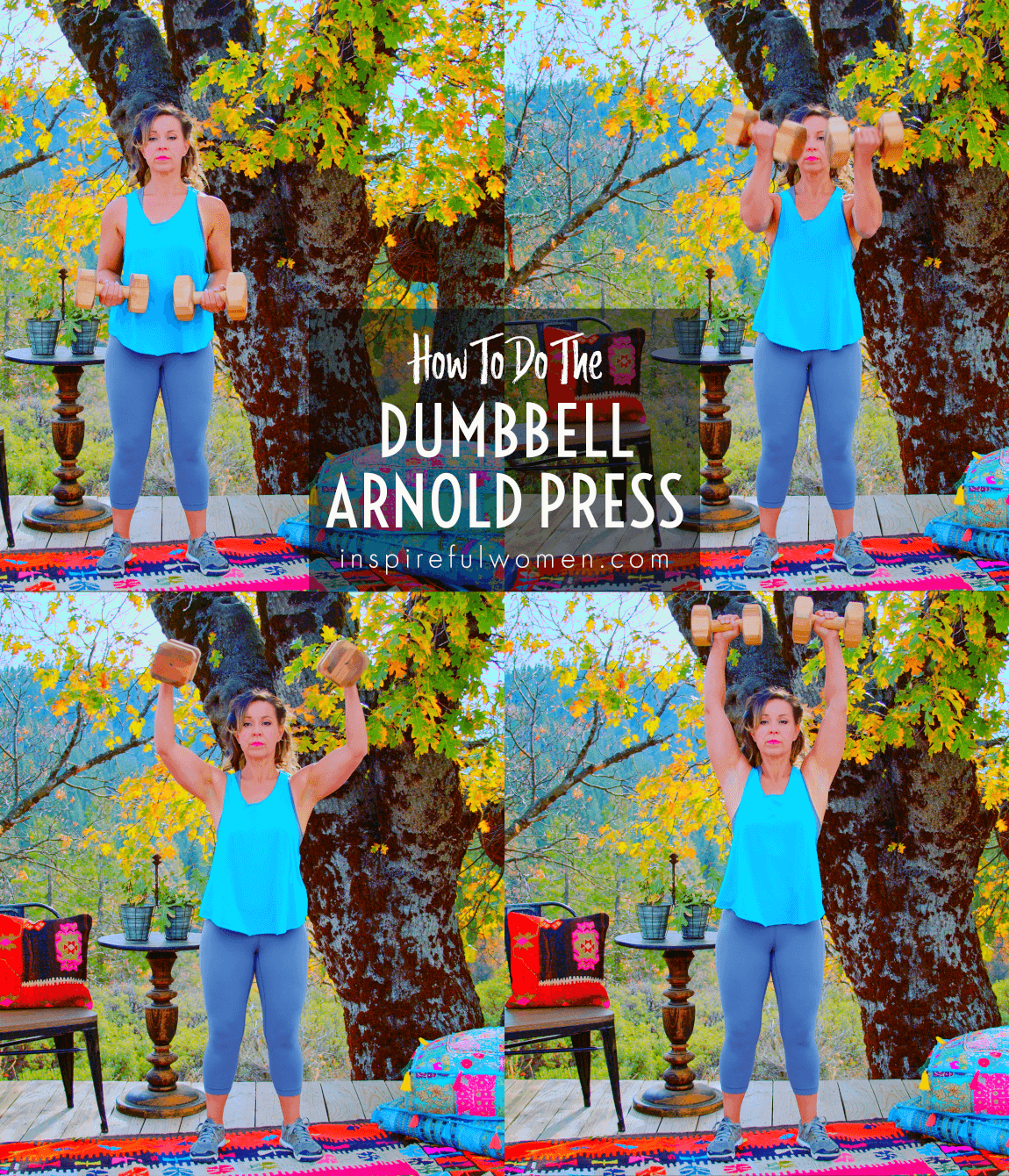
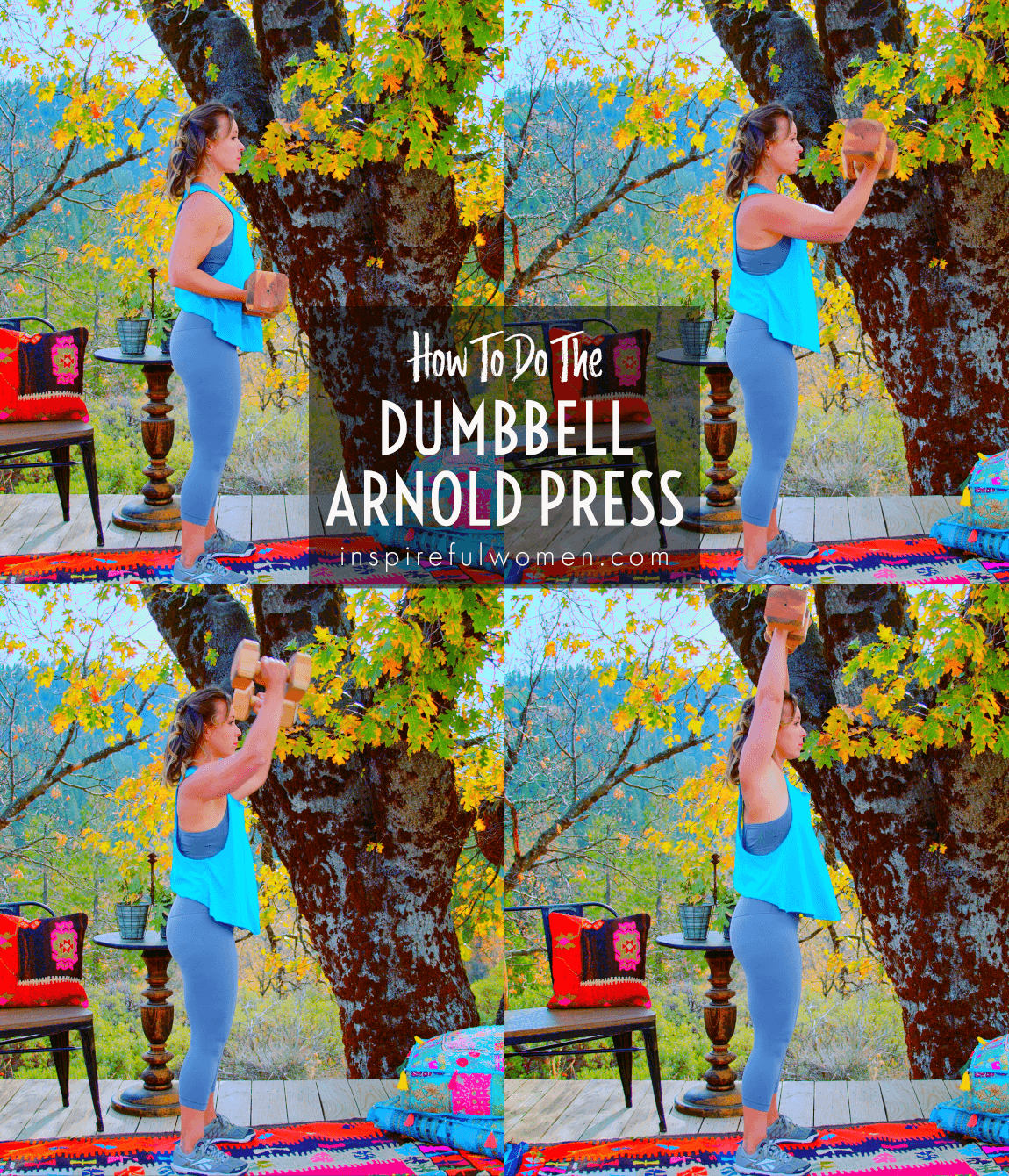
COMMON MISTAKES
COMMON MISTAKES
WHAT TO AVOID WITH THE Dumbbell Arnold Press
KEY TIP:
Guess what? Good news! Many avoids are the same for most movements. Once you learn the basics, there's really only a few extra avoids for each individual movement.
1. Avoid Dropping Weight Back Down
AVOID: Letting the arms drop.
WHY NOT?
- The ability to control the movement as gravity is pulling the arms down is a very important part of the exercise (eccentric muscle contraction.
WHAT TO DO:
- When the arms come down the movement should be slow and controlled.
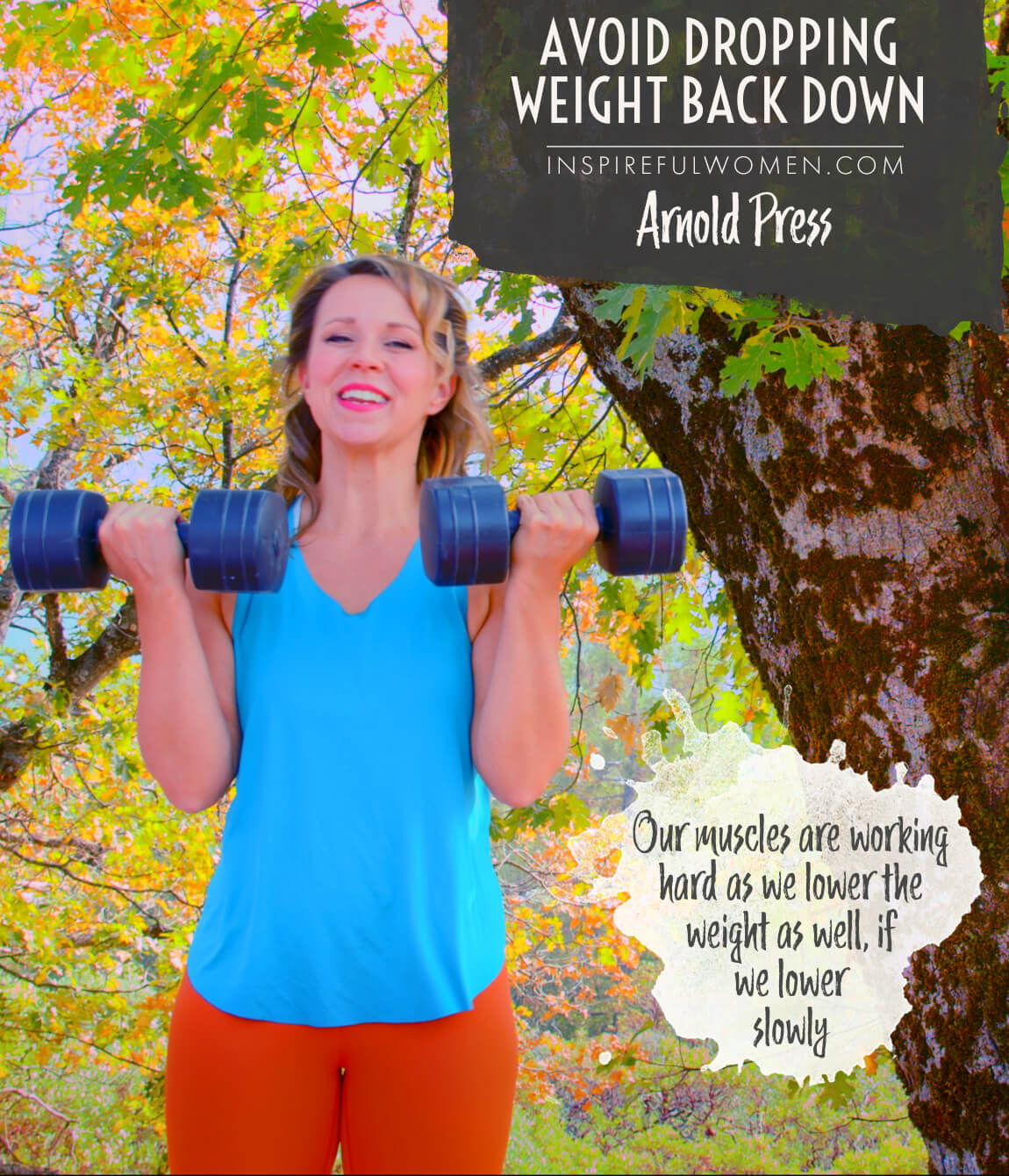
2. Avoid Rounding Shoulders Forward
AVOID: Letting the shoulder blades protract (move forward on the rib cage) as the arms move down.
WHY NOT?
- This puts the shoulder joint in a position that could irritate the bicep and rotator cuff tendons.
WHAT TO DO:
- Keep the shoulder blades tight together/retracted.
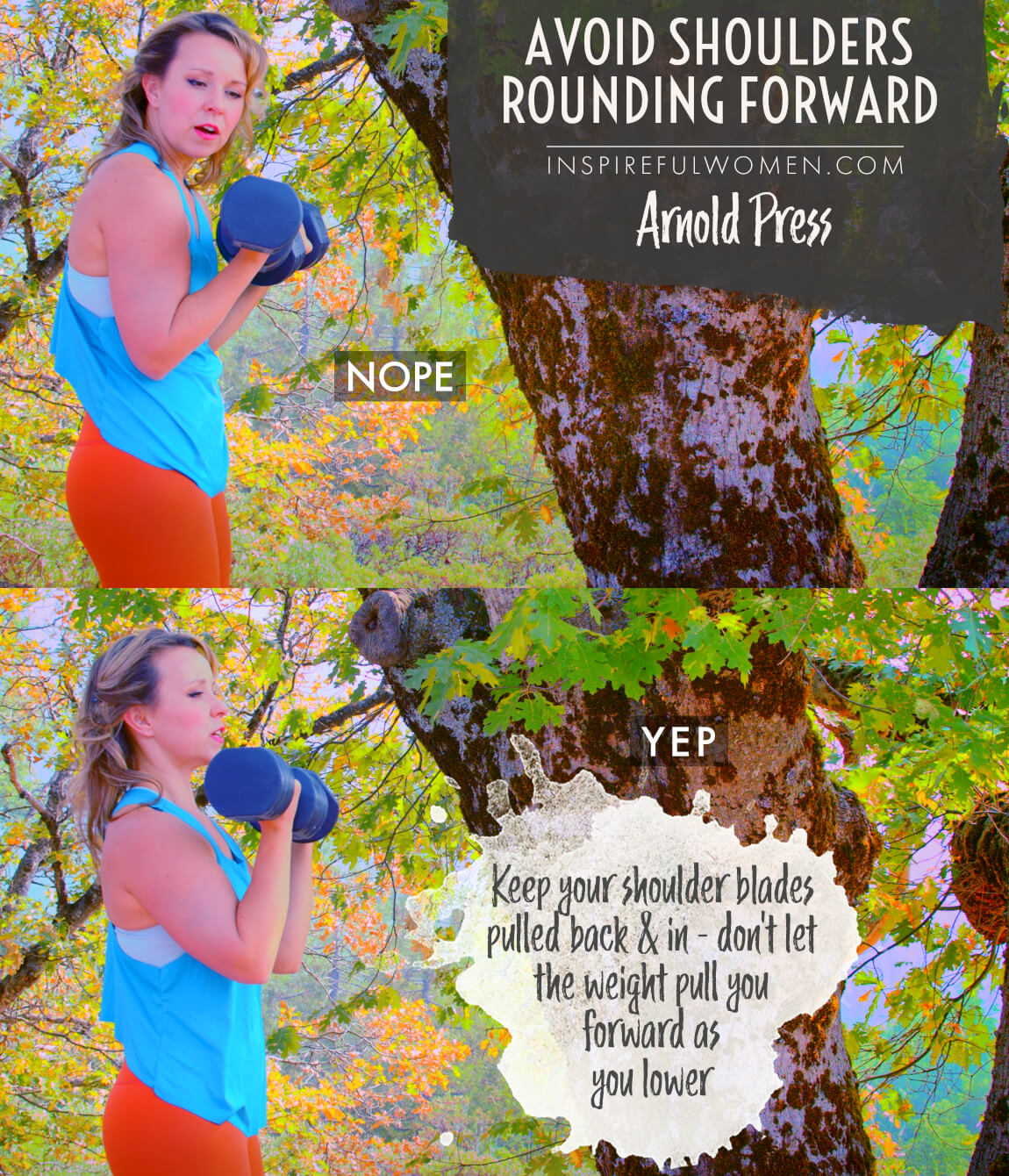
3. Avoid Shoulders Rising Up towards Ears
AVOID: Letting the shoulders to rise up close to your ears as you take your arms up overhead.
WHY NOT?
- This can happen when you use too much resistance or your muscles are getting tired.
- The upper trap will lift the shoulder blade up and the space between the top of the shoulder will rise up towards the earlobe.
- This means that you are trying to use the wrong muscles - the muscles that cross your neck, to lift the weight.
- This can result in neck or shoulder pain and will not strengthen the targeted muscles (will train poor body mechanics).
WHAT TO DO:
- Keep your shoulder blades down (they will rotate up but they should not move up your back).
- Keep space between the top of the shoulder and the earlobe, lift the sternum, and activate the core muscles.
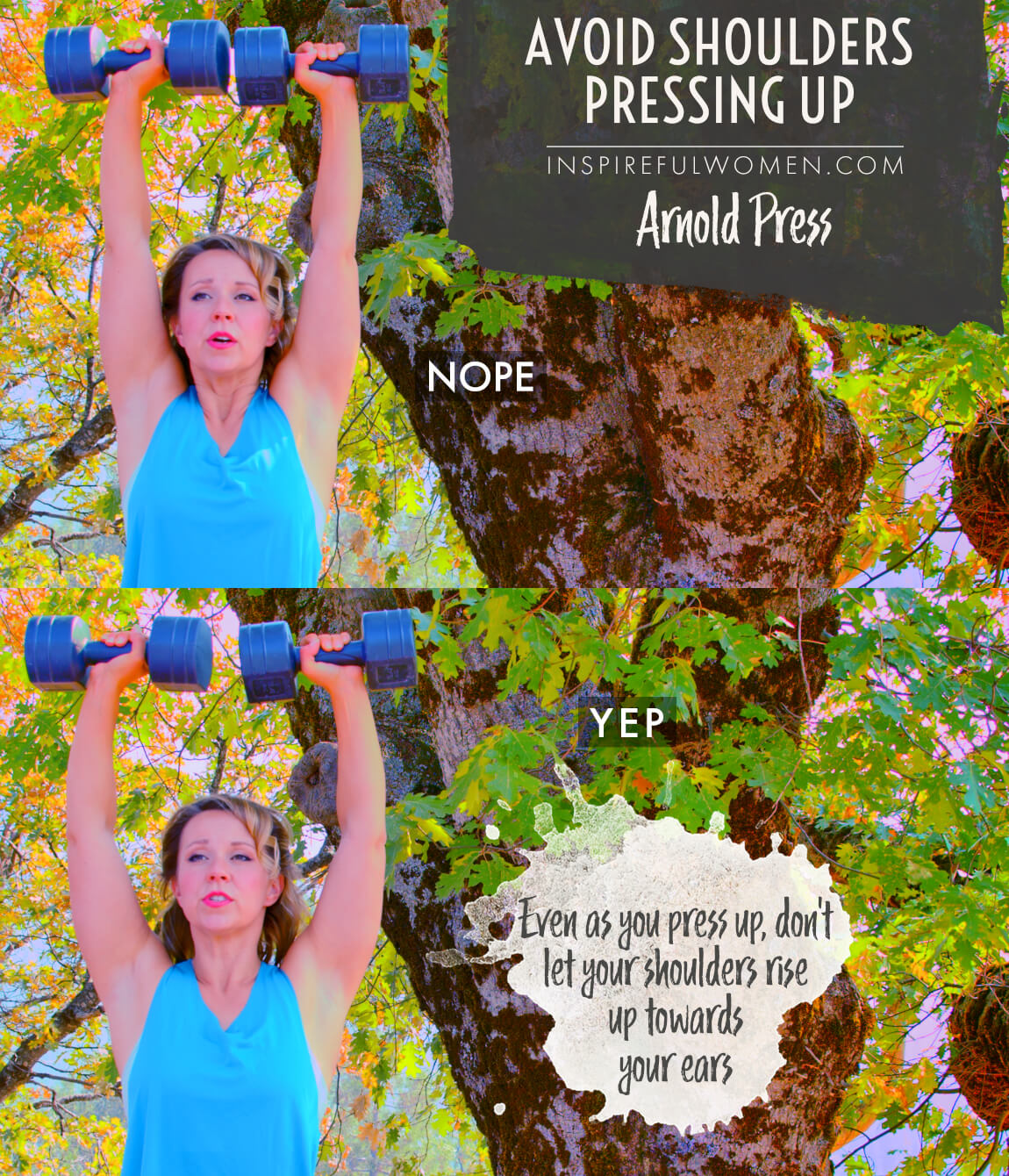
4. Avoid Misalignment of Forearms
AVOID: Letting the arms and elbows cave in front of you too much/too close together
WHAT TO DO:
- Elbows should be in line with the shoulders and the hands.
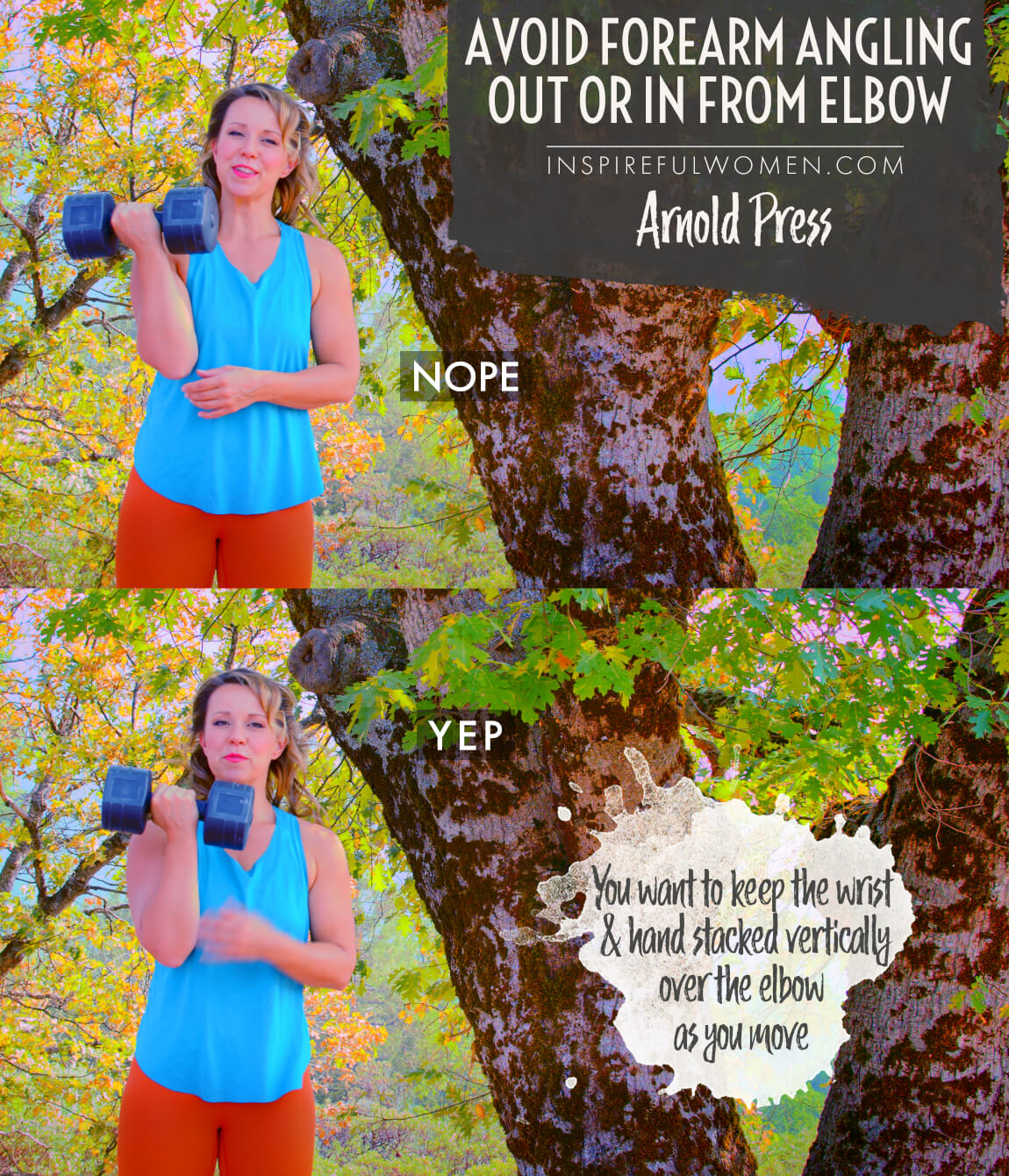
VARIATIONS
VARIATIONS
VARIATIONS OF Dumbbell Arnold Presses
Keep Tension On Muscle
Keep Tension On Muscle
Keeping the shoulder in a bit of flexion (not bringing the elbow too far down) will keep some tension on the deltoid but work the muscle through a slightly smaller range of motion.
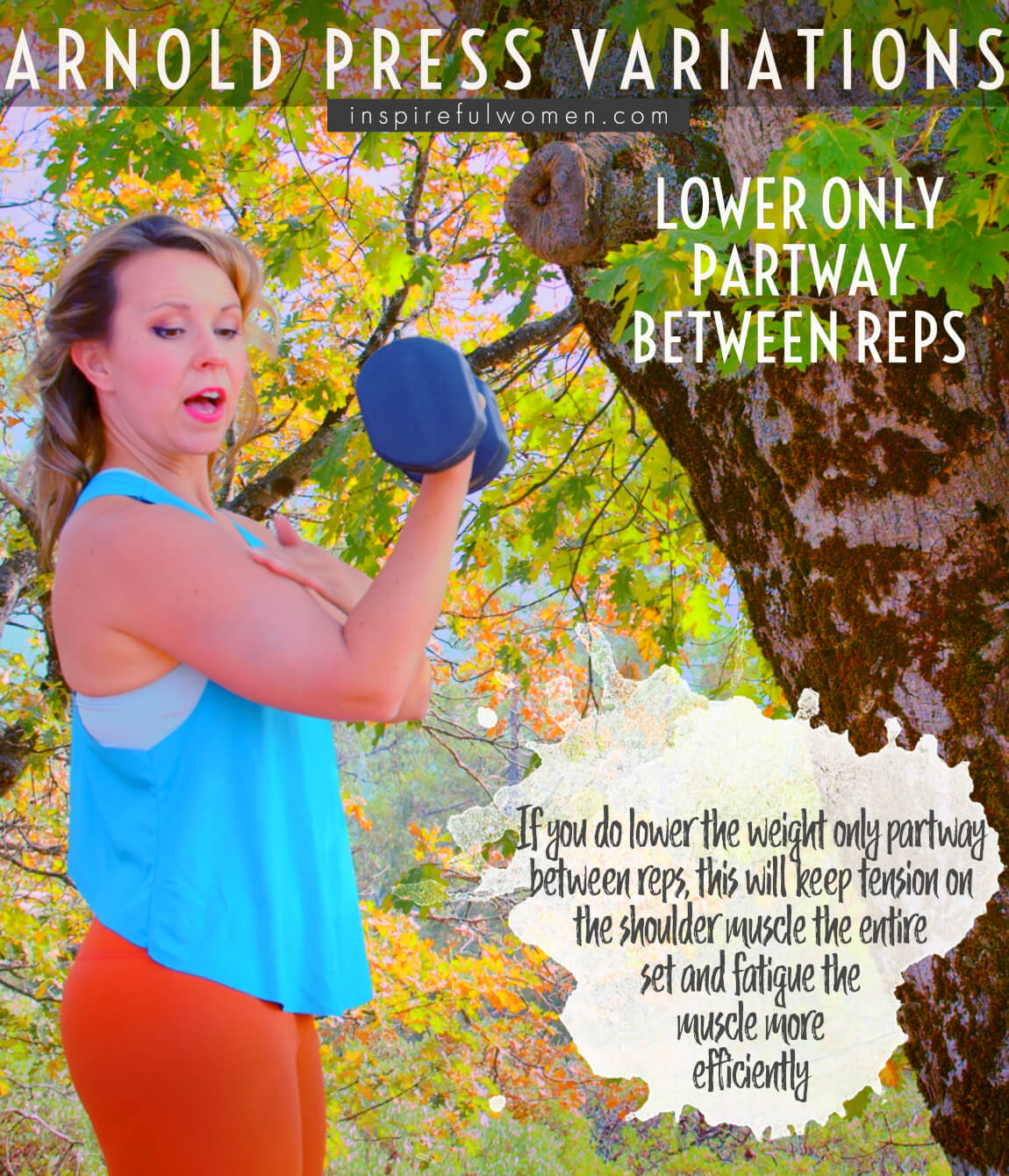
MAKE IT HARDER
HARDER
MAKING THE Dumbbell Arnold Press MORE CHALLENGING
Heavier weight
Heavier weight Arnold Press
The weight gets heavier all portions of the deltoid will work harder.
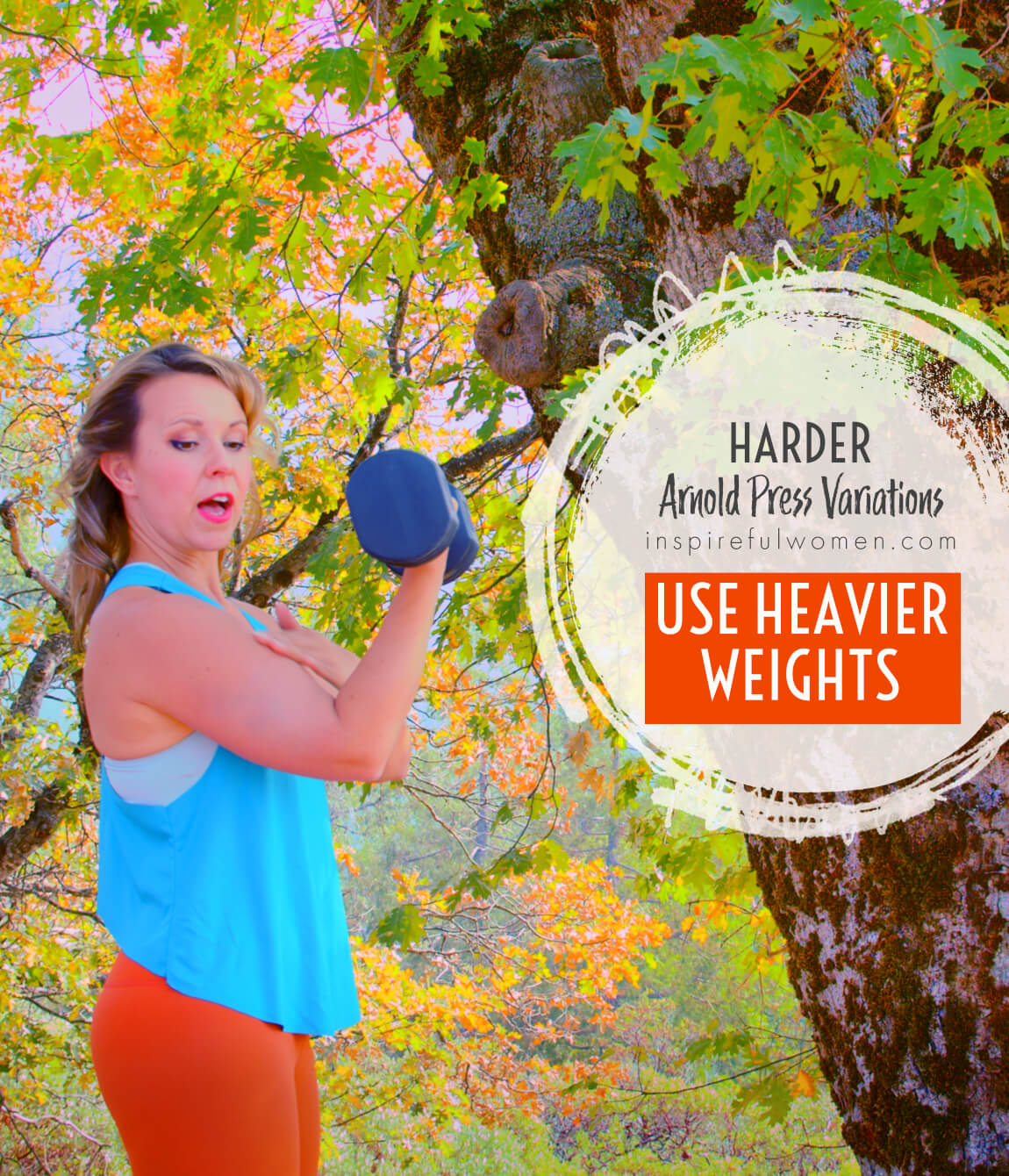
Single Arm
Single Arm Dumbbell Arnold Press
Single arm press but holding the non-moving arm in the overhead press position

Alternating Press
Alternating dumbbell arnold press
This is just another way to do this movement. Alternating arms with each rep does a few things. First, it gives the muscles of each a slight "break" to recover between reps, which can allow you to either lift a little more weight OR do few more reps than if you weren't alternating.
Second, alternating means that you only have 1 arm to pay attention to lifting with good form.
Third, this will work your core muscles differently- these muscles will have adjust and work in response to a load transferring back and forth on your body - this will work your side core muscles more like the obliques & quadratus lumborum.

Eccentric
Eccentric Dumbbell Arnold Press
Increase time under tension/eccentric phase with 5-10 sec lowering
MAKE IT EASIER
EASIER
MAKE THE Dumbbell Arnold Press MORE DOABLE
Single Arm
Single Arm Dumbbell Arnold Press
Doing the Arnold Press one arm at a time does a few things. One, you can often lift more weight. Second, your mind has only one limb to focus on instead of two, which I find makes it easier to use good form. Third, this will work your core muscles differently than a two-armed version. It will challenge your obliques & QL (the sides of your core) more.
Stability Ball
Stability Ball Arnold Press
Great variation that can be done which will challenge core/pelvic stability - you need to ensure that when on the ball, maintain a neutral spine and avoid going into an excessive posterior pelvic tilt or “sacral sitting” posture.
Sacral sitting: pelvis is tilted in such a way that all the pressure is placed directly on the sacrum. Creating a C shape with the spine, flattening the lumbar curve. Excessive forward neck flexion causes chest and abdominal constriction. The organs housed in the chest and abdomen are unable to function properly.
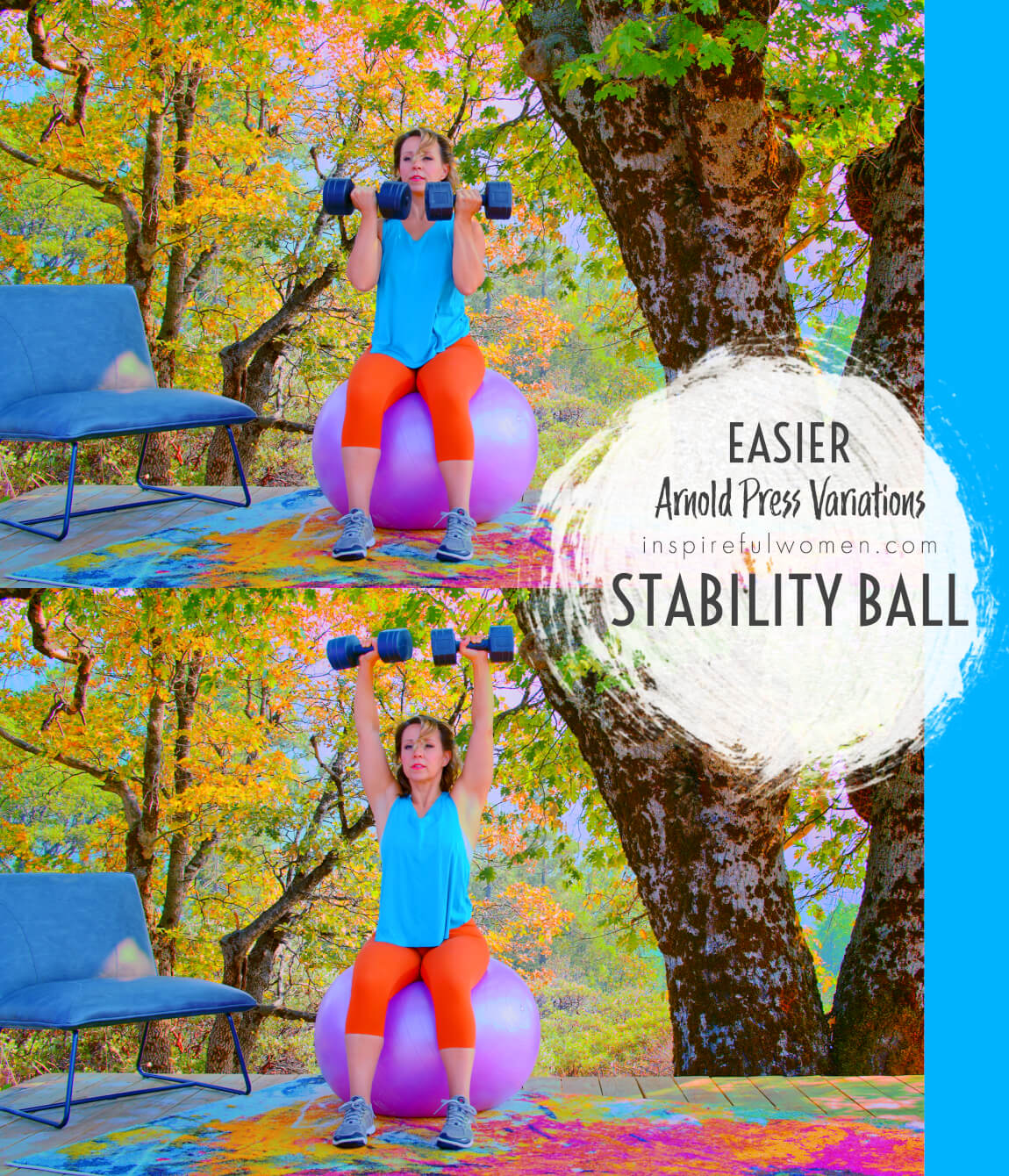
Seated w/ lighter weights
Seated on a chair with lighter weights arnold press
Sit upright with a neutral spine and use lighter weights.
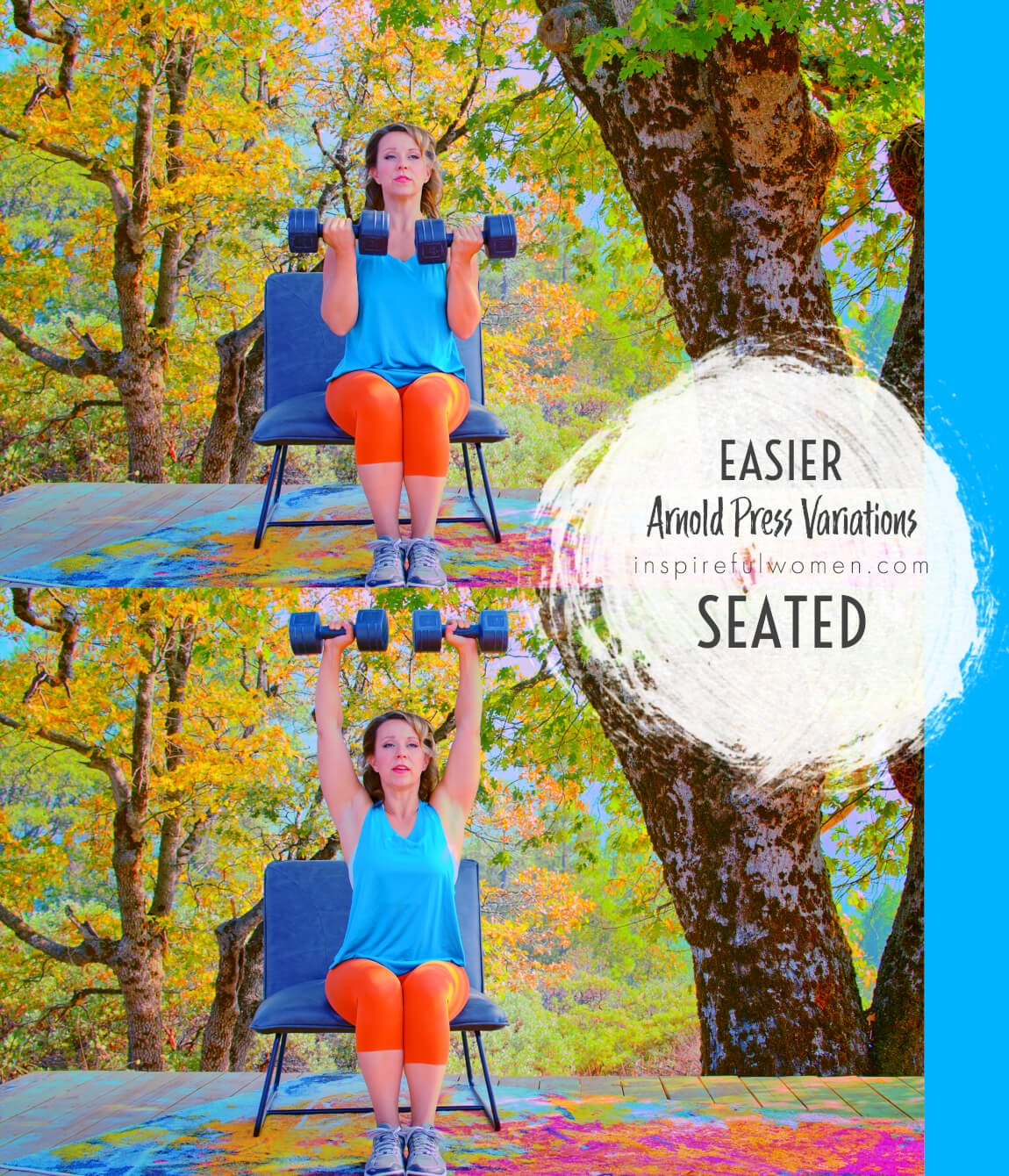
break down the move
Break down the movement to 3 phases
Practice 3 phases of the movement with pauses between then work at making it more fluid. It may be helpful to practice the movement without any weights at first, and even use visual aid such as a mirror or record yourself on your cell phone to ensure proper positioning and technique. You can even break up the movement with a pause -start the movement and rotate the palms outward into what would be the start of a regular shoulder press, PAUSE, then press up from there. Same can be broken up when you reverse it on the way back down.
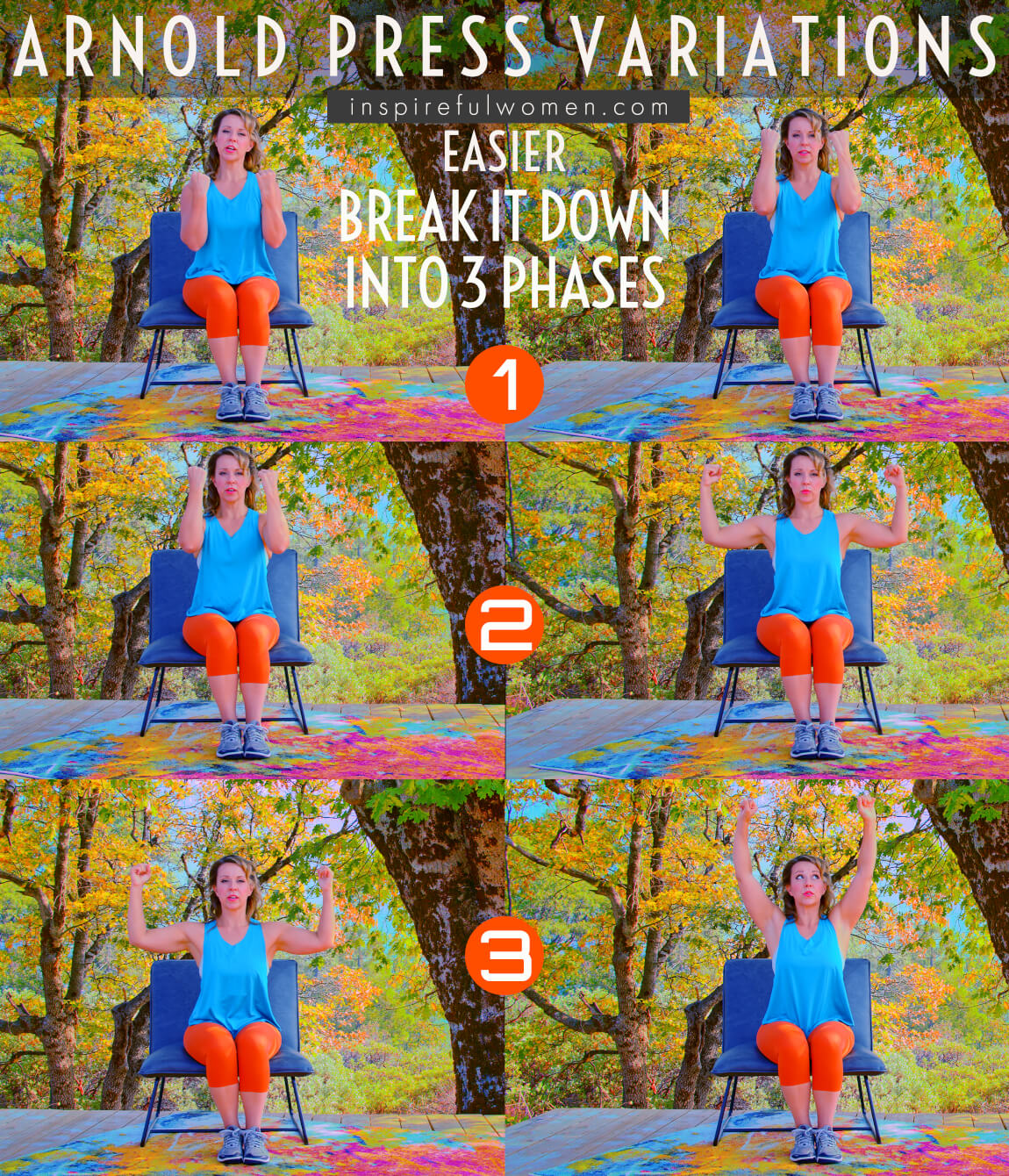
SCIENCY STUFF
ALLLL MUSCLES & WHEN
ALL MUSCLES WORKING & WHEN DURING THE Dumbbell Arnold Press
The scapular stabilizers are active to hold the shoulder blades down and back. The muscles that cross the wrist and elbow work to stabilize the joints throughout the movement.
The anterior deltoid, biceps and coracobrachialis work concentrically to flex the arm. As the arms lift up they begin to move out to the side (into abduction) of the body - the rotator cuff muscles and scapular (shoulder blade) stabilizers work to coordinate the small movements of the shoulder blade and upper arm bone (humerus). Middle (medial) deltoid (concentric contraction) becomes more active as the arms are abducted (away from the body) approaching that midway, shoulder-height level and above. As the upper arm rotates back into extension and the arm is straightened, the rear deltoid and infraspinatus (concentric contraction) becomes more active. The triceps work to straighten the elbow as the arm pushes up over head.
PIN IT FOR LATER!
